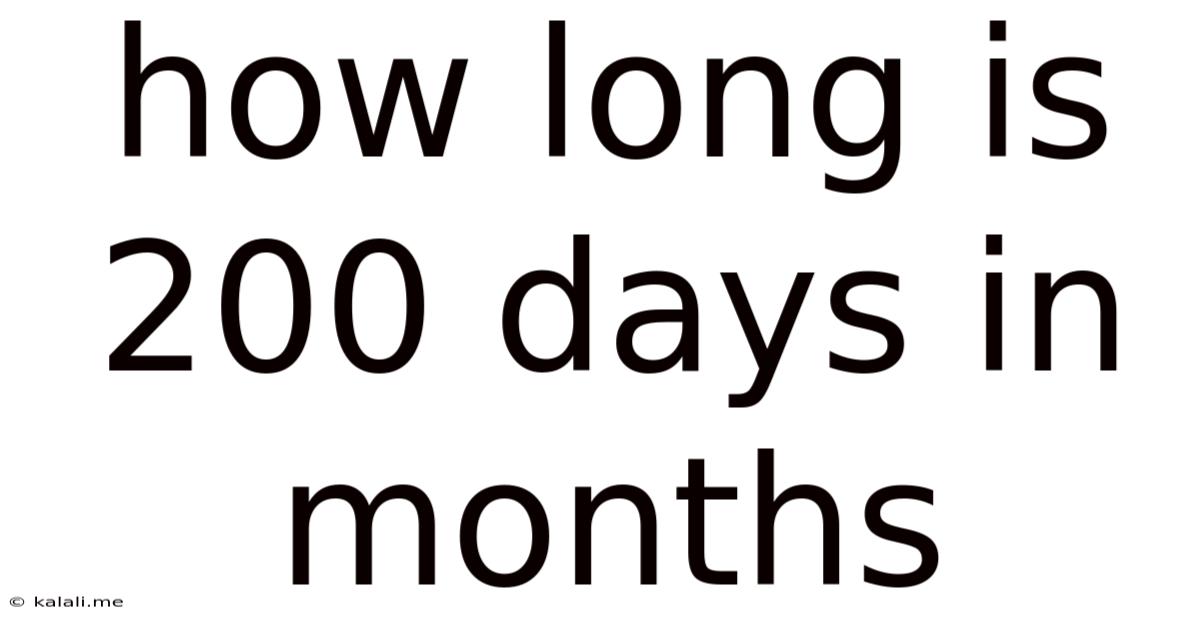How Long Is 200 Days In Months
Kalali
Jul 14, 2025 · 4 min read

Table of Contents
How Long is 200 Days in Months? A Comprehensive Guide to Time Conversion
Knowing how to convert days into months is a valuable skill, whether you're planning a long trip, tracking a project deadline, or simply curious about timeframes. This article delves into the intricacies of converting 200 days into months, explaining the process, highlighting potential complexities, and providing practical examples to solidify your understanding. This seemingly simple question opens a door to a deeper understanding of calendar systems and their impact on time calculations.
Understanding the Challenges of Day-to-Month Conversion
Unlike converting between units with fixed ratios (like centimeters and meters), converting days to months is not straightforward. This is because months have varying lengths: 28, 29, 30, or 31 days. This variability introduces a significant level of complexity to the calculation. A precise conversion requires considering the specific calendar year and the months encompassed within the 200-day period.
Method 1: The Average Month Approach (A Simplified Calculation)
The simplest, albeit least accurate, method involves using the average length of a month. While not perfectly precise, it provides a quick estimate. The average length of a month is approximately 30.44 days (365.25 days per year / 12 months).
To estimate the number of months in 200 days using this method:
200 days / 30.44 days/month ≈ 6.57 months
This indicates that 200 days is roughly equivalent to 6.57 months. However, it's crucial to remember that this is just an approximation. The actual number of months will vary depending on the specific start date and the year.
Method 2: The Precise Calculation (Considering Specific Dates)
For a precise conversion, we need to know the starting date. Let's assume we start counting from January 1st of a non-leap year. We can then determine the exact number of months and remaining days.
Let's break down the calculation:
- January: 31 days
- February: 28 days (in a non-leap year)
- March: 31 days
- April: 30 days
- May: 31 days
- June: 30 days
- July: 31 days
Adding these up, we get 202 days. This means that counting from January 1st, 200 days would fall in June, with a few days left over. The exact number of months and days depends on the starting date.
If we start on January 1st, 200 days later would be approximately June 20th. This translates to approximately six months and 19 days. However, if we start on February 1st, the result would be different. This illustrates the variability involved.
Method 3: Using a Calendar or Online Converter
The most convenient and accurate method is to use a calendar or an online date calculator. Simply input the start date and add 200 days. The result will display the corresponding date, allowing you to determine the number of months and remaining days. Many online tools are available that specifically perform this type of calculation.
Practical Examples and Applications
Understanding this conversion is crucial in various contexts:
-
Project Management: If a project has a 200-day timeline, knowing the equivalent in months helps with better planning and resource allocation. It allows for a more realistic breakdown of tasks and milestones across monthly periods.
-
Financial Planning: Investment strategies, loan repayments, and budgeting often involve periods spanning months. Understanding the equivalent number of days allows for more precise calculations.
-
Travel Planning: Planning a trip lasting 200 days requires understanding the number of months involved for visa applications, flight bookings, and accommodation arrangements.
-
Personal Goal Setting: Tracking progress towards a personal goal over 200 days can be better managed by breaking it down into monthly milestones.
Leap Years and Their Influence
Leap years introduce another layer of complexity. The presence of an extra day (February 29th) alters the calculation. If the 200-day period spans a leap year, the end date will be one day later compared to a non-leap year, affecting the exact number of months and days.
Advanced Considerations: Calendar Systems and Cultural Differences
While the Gregorian calendar is the most widely used internationally, other calendar systems exist (e.g., the Julian calendar, Islamic calendar). Converting days to months would require adapting the calculation to the specificities of each calendar system. This highlights the importance of specifying the calendar system being used when discussing time conversions.
Conclusion: A Multifaceted Calculation
Converting 200 days to months isn't a simple division problem. The varying lengths of months make it a nuanced calculation requiring context. While the average month approach provides a quick estimate, accurate conversion demands considering the start date and the influence of leap years. Utilizing a calendar or online date calculator provides the most precise and convenient method for this task. Understanding the complexities of this conversion empowers you to make more accurate estimations and plans across different timeframes. This deeper understanding is crucial for various applications, ranging from personal planning to sophisticated project management. Remember to always specify the starting date and calendar year for the most accurate calculation.
Latest Posts
Latest Posts
-
If Im 33 What Year Was I Born
Jul 14, 2025
-
How Many Acres Is 8000 Square Feet
Jul 14, 2025
-
Are Helen Hunt And Bonnie Hunt Related
Jul 14, 2025
-
How Many 6 Are In A Deck Of Cards
Jul 14, 2025
-
Is Onion A Vegetable Or A Fruit
Jul 14, 2025
Related Post
Thank you for visiting our website which covers about How Long Is 200 Days In Months . We hope the information provided has been useful to you. Feel free to contact us if you have any questions or need further assistance. See you next time and don't miss to bookmark.